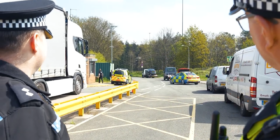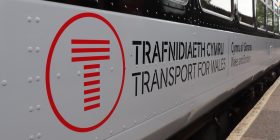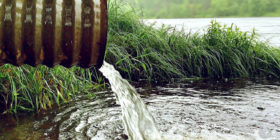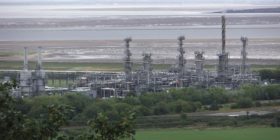Deeside corridor consultation: Public exhibition moves to Coleg Cambria Deeside Campus

[vc_row][vc_column][vc_column_text]The A55 / A494 / A548 Deeside Corridor public exhibition moves to Coleg Cambria this morning, memebrs of the public will be able to go along from 10am to 8pm on Thursday and Friday to view detailed plans around the proposed.
Two events were held in at Ewloe Social Club earlier this week, Tuesday’s event attracted around 680 people on the day.
The exhibitions are part of the 12 week consultation process launched by the government last week and looks at two proposals each costing in excess of £200m.
The proposed Red and Blue Route options will see improvements to either the existing A494 through Queensferry along Aston Hill to Northop or greater use of the A548 over the Flintshire Bridge with new link road to the A55 at Northop.
The scheme will aim to address the long standing issues associated with the stretch of trunk road through Deeside which experiences more traffic than it was designed for, and is “below modern standards.”
The road has nowhere for broken down vehicles to pull off and some junctions have slip roads that are too short or too close to the road, It’s at these junctions that the majority of accidents occur according to the government.
The Welsh Government’s ‘National Transport Finance Plan’ published back in July 2015 was the initial launch pad for the proposed improvement scheme investment.[/vc_column_text][vc_cta h2=”Deeside Corridor Public Exhibitions” h2_font_container=”font_size:32px|color:%23712b47|line_height:24px” h2_google_fonts=”font_family:Arvo%3Aregular%2Citalic%2C700%2C700italic|font_style:400%20regular%3A400%3Anormal” shape=”square” style=”3d” color=”grey” add_icon=”top” i_icon_fontawesome=”fa fa-info-circle” i_color=”green” use_custom_fonts_h2=”true” i_on_border=”true” css=”.vc_custom_1490003812844{margin-top: -12px !important;}”]March 21 & 22 – Ewloe Social Club – 10am to 8pm
March 23 & 24 – Coleg Cambria, Deeside campus – 10am to 8pm[/vc_cta][vc_column_text]However, plans were put forward in 2007 by the Welsh Government as part of the “Transport Strategy For Wales” which would have seen widespread development of the creaking transport system around Deeside the A494 and A55.
A blueprint was drawn up to develop 2.5-mile stretch of the road to four lanes uphill and three lanes downhill with a 70mph speed.
Through compulsory purchase orders the Welsh Government bought 43 homes on the Aston Mead estate next to the A494, the homes were demolished in 2009 and the land left empty after the £71m road improvement project was ditched following a public inquiry.
The Welsh Government still owns pockets of land along the A494 in Aston including a strip alongside the Llys Gary Speed development, a new 21 home affordable housing scheme built on the Aston Mead site, which would allow for Blue route work if that was the chosen option.
The so called Blue route includes widening work on around 9.8km of road, the A494 would increase to three lanes in both directions and junction improvements including at Ewloe Interchange at a cost to taxpayers of around £283.0m
The Red route would see an increased capacity along the existing A548 with a new road linking the A55 and A548 just after the Flintshire Bridge, red route cost would be in the region of £255.4m.[/vc_column_text][vc_row_inner][vc_column_inner el_class=”blue” width=”1/2″][vc_column_text css=”.vc_custom_1489487930051{padding-top: 6px !important;background-color: #bf0000 !important;}”]
[miptheme_spacer height=”4″]Red Route Option:
• Increased capacity along the existing A548;
• A new road between the A55 and A548;
• Modification and improvement of junctions
• 2 lanes in each direction
• Approximate length 13.0km – partly online improvement and partly new alignment
[miptheme_spacer height=”2″][/vc_column_text][/vc_column_inner][vc_column_inner width=”1/2″][vc_column_text css=”.vc_custom_1489487671984{padding-top: 6px !important;background-color: #013b87 !important;}”]
Blue Route Option:
• Widening the A55/A494 route
• Junction improvements including at Ewloe Interchange;
• Parallel link roads • Removal, modification and improvement of junctions
• 3 lanes in each direction
• Approximate length 9.8km
[/vc_column_text][/vc_column_inner][/vc_row_inner][vc_column_text][icon name=”search-plus” class=”” unprefixed_class=””] Hover over image to zoom | [icon name=”external-link-square” class=”” unprefixed_class=””] Larger Image
 [/vc_column_text][vc_column_text]
[/vc_column_text][vc_column_text]
Planning Objectives
The Welsh Government has set 10 planning objectives for the A55 / A494 / A548 Deeside Corridor Improvement programme, at the heart of the project is the reduction of bottlenecks on the road, keeping motorists safe, improved access to key employment areas in the Deeside Enterprise Zone and environmental factors.
The aims of the scheme are to:
- improve capacity, reliability and journey times
- improve safety
- improve connections for businesses
- improve access between residential areas and places of employment
- reduce carbon emissions along the road
- make more efficient use of the existing transport infrastructure.
[/vc_column_text][vc_tta_accordion style=”flat” shape=”square” color=”black” spacing=”2″ gap=”2″ c_icon=”chevron” active_section=”1″ collapsible_all=”true” css=”.vc_custom_1489502886217{margin-top: -20px !important;}”][vc_tta_section title=”The ten objectives” tab_id=”1489484562355-2576f88e-b62f”][vc_row_inner equal_height=”yes”][vc_column_inner width=”1/2″][vc_column_text]1. To reduce journey time variability and enhance the transport network resilience of the A55/A494 study corridor to periods of high demand, incidents and maintenance events.
2. To improve transport connections for businesses within the study area to key economic centres and employment sites.
3. To improve access between employment sites and workforce catchment areas.
4. To improve the actual and perceived safety and personal security of all transport users along the A55/ A494 study corridor.
5. To improve the permeability across the A55/A494 corridor for non-motorised modes at key points of desire.[/vc_column_text][/vc_column_inner][vc_column_inner width=”1/2″][vc_column_text]6. To ensure that the study area transport network facilitates necessary national and regional trip movements of people and freight.
7. To reduce carbon emissions from transport along the A55/A494 study corridor.
8. To minimise adverse impacts on the human environment including air, noise and light pollution, and landscape and townscape.
9. To minimise adverse impacts on the natural environment including local air quality, water and soil pollution, and biodiversity impacts.
10.To maintain and make more efficient use of the existing transport infrastructure along the A55/A494 study[/vc_column_text][/vc_column_inner][/vc_row_inner][/vc_tta_section][/vc_tta_accordion][/vc_column][/vc_row][vc_row][vc_column][vc_column_text]Renewal of the A494 Dee Bridge muted in the North Wales Metro document published last week is a separate scheme will be done independently of the outcome the Blue and Red Route consultation and outcome.
This sets out the Welsh Government’s vision for an integrated transport network across North Wales and the development of a North East Wales Metro.
The proposed Red Route would bring a new trunk road linking the A548 and A55 through a rural area ‘not currently exposed to traffic’
There would be a loss of around 56 hectares agricultural land and ancient woodland between Northop and Kelsterton, land owners would be financial compensated.
One residential property, the new solar farm at Shotwick and land allocated for industry would be directly affected by the Red Route option again financial compensation would be provided.
The Red Route would also intersect designated footpaths, cycleways, bridleways and numerous footways, creating new severance which would be “mitigated by the provision of alternative routes.”
The Blue Route proposal would see a loss of ‘farmsteads and dwellings’ affecting around 12.5ha of agricultural land and farm businesses.
Seven residential properties and five commercial properties would be directly affected by the need to use land on the Blue Route, financial compensation would be provided.
The proposed Blue Route would encroach into several locally designated green barriers in the Flintshire UDP footpaths, cycleways and footways would be affected, and alternative provision would be made.
Both Options will contain facilities for ‘non motorised’ users such as cyclists and pedestrians according to the documents published.[/vc_column_text][vc_custom_heading text=”Traffic Noise” font_container=”tag:h3|font_size:18px|text_align:left|color:%23000000″ google_fonts=”font_family:Arimo%3Aregular%2Citalic%2C700%2C700italic|font_style:700%20bold%20regular%3A700%3Anormal”][/vc_column][/vc_row][vc_row equal_height=”yes”][vc_column width=”1/2″ css=”.vc_custom_1489450897678{background-color: #bf0000 !important;}”][vc_column_text css=”.vc_custom_1489488009098{padding-right: 5px !important;padding-left: 15px !important;}”]Red Route: would bring a new trunk road through a rural area not currently exposed to traffic noise in close proximity, and add traffic to the existing A548 route.
Noise impacts at residential properties depend on location, however mitigation at strategic locations may achieve a reduction in the noise effects at properties most affected.[/vc_column_text][/vc_column][vc_column width=”1/2″ css=”.vc_custom_1489450880334{background-color: #013b87 !important;}”][vc_column_text css=”.vc_custom_1489488037510{padding-right: 5px !important;padding-left: 15px !important;}”]Blue Route: At most residential properties, traffic noise is not expected to change noticeably.
However, new and remodelled junctions would increase traffic noise along some local roads.[/vc_column_text][/vc_column][/vc_row][vc_row][vc_column][vc_custom_heading text=”Greenhouse Gas Emissions ” font_container=”tag:h3|font_size:18px|text_align:left|color:%23000000″ google_fonts=”font_family:Arimo%3Aregular%2Citalic%2C700%2C700italic|font_style:700%20bold%20regular%3A700%3Anormal”][vc_column_text]Increased slightly under both Options as a result of an increased number of journeys which outweighs the emission benefits of improvement to traffic flow.[/vc_column_text][vc_custom_heading text=”Local Air Quality” font_container=”tag:h3|font_size:18px|text_align:left|color:%23000000″ google_fonts=”font_family:Arimo%3Aregular%2Citalic%2C700%2C700italic|font_style:700%20bold%20regular%3A700%3Anormal”][vc_column_text]No locations would exceed the objectives for PM10 with either Option, and refining the alignment and future improvements in vehicle emissions are predicted to reduce exposure to both NO2 and PM10.[/vc_column_text][/vc_column][/vc_row][vc_row equal_height=”yes”][vc_column width=”1/2″ css=”.vc_custom_1489450897678{background-color: #bf0000 !important;}”][vc_column_text css=”.vc_custom_1489488089613{padding-right: 5px !important;padding-left: 15px !important;}”]Red Route: would reduce traffic on the A55 and A494 and so reduce both NO2 and particulates (PM10) concentrations for nearby residents, but introduce increased traffic emissions (both NO2 and PM10) at locations near the Red Option.[/vc_column_text][/vc_column][vc_column width=”1/2″ css=”.vc_custom_1489450880334{background-color: #013b87 !important;}”][vc_column_text css=”.vc_custom_1489488112297{padding-right: 5px !important;padding-left: 15px !important;}”]Blue Route: is not expected to increase the small number of sensitive receptor locations exceeding annual mean air quality objectives (NO2) in the opening year (2022) using conservative predictions for vehicles.[/vc_column_text][/vc_column][/vc_row][vc_row][vc_column][vc_custom_heading text=”Landscape and Townscape” font_container=”tag:h3|font_size:18px|text_align:left|color:%23000000″ google_fonts=”font_family:Arimo%3Aregular%2Citalic%2C700%2C700italic|font_style:700%20bold%20regular%3A700%3Anormal”][/vc_column][/vc_row][vc_row equal_height=”yes”][vc_column width=”1/2″ css=”.vc_custom_1489450897678{background-color: #bf0000 !important;}”][vc_column_text css=”.vc_custom_1489488139109{padding-right: 5px !important;padding-left: 15px !important;}”]Red Route: would cause a loss of agricultural land and ancient woodland between Northop and Kelsterton.
Mitigation by reinstatement of landscape features lost to the improvement, and substantial, targeted areas of new woodland planting would develop progressively to replace or improve screening.[/vc_column_text][/vc_column][vc_column width=”1/2″ css=”.vc_custom_1489450880334{background-color: #013b87 !important;}”][vc_column_text css=”.vc_custom_1489488157087{padding-right: 5px !important;padding-left: 15px !important;}”]Blue Route: affected by loss of farmsteads and dwellings and severance of public footpaths. Vegetation loss, additional road surface area, elevation of junctions, additional lighting and similar changes. [/vc_column_text][/vc_column][/vc_row][vc_row][vc_column][vc_custom_heading text=”Communities and Land Use” font_container=”tag:h3|font_size:18px|text_align:left|color:%23000000″ google_fonts=”font_family:Arimo%3Aregular%2Citalic%2C700%2C700italic|font_style:700%20bold%20regular%3A700%3Anormal”][/vc_column][/vc_row][vc_row equal_height=”yes”][vc_column width=”1/2″ css=”.vc_custom_1489450897678{background-color: #bf0000 !important;}”][vc_column_text css=”.vc_custom_1489488440103{padding-right: 5px !important;padding-left: 15px !important;}”]Red Route: likely to affect about 56ha of agricultural land and farm businesses. Mitigation would be by financial compensation and by accommodation works.
One residential property, the new solar farm at Shotwick and land allocated for industry would be directly affected by the need to use land, and financial compensation would be provided.
Red Route: would cross several green barriers. It would intersect designated footpaths, cycleways, bridleways and numerous footways, creating new severance which would be mitigated by the provision of alternative routes[/vc_column_text][/vc_column][vc_column width=”1/2″ css=”.vc_custom_1489450880334{background-color: #013b87 !important;}”][vc_column_text css=”.vc_custom_1489488461296{padding-right: 5px !important;padding-left: 15px !important;}”]Blue Route: likely to affect about 12.5ha of agricultural land and farm businesses.
Mitigation would be by financial compensation and accommodation works.
Seven residential properties and five commercial properties would be directly affected by the need to use land, and financial compensation
would be provided.
Blue Route: would encroach into several locally designated green barriers in the Flintshire UDP and intended to prevent coalescence of settlements.
Footpaths, cycleways and footways would be affected, and alternative provision would be made.[/vc_column_text][/vc_column][/vc_row][vc_row][vc_column][/vc_column][/vc_row][vc_row][vc_column][vc_custom_heading text=”Biodiversity” font_container=”tag:h3|font_size:18px|text_align:left|color:%23000000″ google_fonts=”font_family:Arimo%3Aregular%2Citalic%2C700%2C700italic|font_style:700%20bold%20regular%3A700%3Anormal”][vc_column_text]Both Options would lead to a loss of habitat from protected sites shown on pages 8 and 9, mitigation will be essential. Both Options would lead to a loss of woodland and grassland habitat along the corridor, likely to affect protected and other species. New habitats and connections would be created as mitigation where possible.[/vc_column_text][/vc_column][/vc_row][vc_row][vc_column][vc_custom_heading text=”Heritage sites” font_container=”tag:h3|font_size:18px|text_align:left|color:%23000000″ google_fonts=”font_family:Arimo%3Aregular%2Citalic%2C700%2C700italic|font_style:700%20bold%20regular%3A700%3Anormal”][vc_column_text]Both Option corridors contain sites which are mainly in the form of buildings which would not be directly affected, or features of low significance.[/vc_column_text][/vc_column][/vc_row][vc_row][vc_column][vc_custom_heading text=”Water environment” font_container=”tag:h3|font_size:18px|text_align:left|color:%23000000″ google_fonts=”font_family:Arimo%3Aregular%2Citalic%2C700%2C700italic|font_style:700%20bold%20regular%3A700%3Anormal”][vc_column_text]Both Options would require some new culverts and diversions of watercourses. Mitigation by designing to balance flows, protect water quality and reinstate habitats would limit the negative effects.[/vc_column_text][/vc_column][/vc_row][vc_row][vc_column][vc_custom_heading text=”Soils and geology” font_container=”tag:h3|font_size:18px|text_align:left|color:%23000000″ google_fonts=”font_family:Arimo%3Aregular%2Citalic%2C700%2C700italic|font_style:700%20bold%20regular%3A700%3Anormal”][vc_column_text]Both Options: agricultural soils would be conserved and reused, so there is no predicted change in soil quality and/ or use outside the works, in geological features or aquifers, and no measurable effect on humans, soils, buildings, or other ecosystems, arising from ground contamination.[/vc_column_text][/vc_column][/vc_row][vc_row][vc_column][vc_column_text][/vc_column_text][/vc_column][/vc_row][vc_row][vc_column][vc_column_text]
How to respond to the consultation
Post: Complete and return response form and send to.
FREEPOST
Welsh Government
Sarn Mynach
Llandudno Junction
Conwy
LL31 9RZ.
Download the Response form
Other documents:
[/vc_column_text][/vc_column][/vc_row]
Spotted something? Got a story? Send a Facebook Message | A direct message on Twitter | Email: [email protected] Latest News








